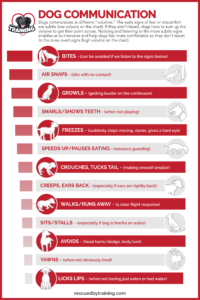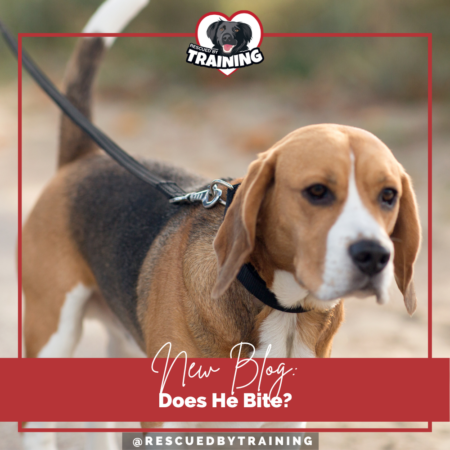Recently I asked for blog topic suggestions and one of the questions submitted was how to answer when people ask “does he bite?” This person also offered that they wanted to keep strangers from petting the dog, so has been saying “yes, he bites” to deter people from approaching. This was such a good question that I wanted to make it my first in my new series, curated by your suggestions, RBT Reader Requests.
Behavior is never random. Dogs rarely bite unprovoked, even if it seems “out of the blue.” Bites happen fast, so it can seem like they happen out of the blue but when we dig into it, we uncover that the dog was fearful in a situation and biting was the only way the dog saw as a way to get relief. Ultimately this comes down to dog communication and body language and the person does not recognizing the dog was fearful or stressed or not understanding the warnings signs that the dog was giving off.
 So what’s the best way to answer the question “does he bite?” The reality is any dog can bite so there’s no guarantee that any dog, even one who hasn’t bitten in the past won’t bite in the future. And we also know that past behavior is the best predictor of future behavior. But that’s a little too much and too nuanced to explain in a brief street interaction.
So what’s the best way to answer the question “does he bite?” The reality is any dog can bite so there’s no guarantee that any dog, even one who hasn’t bitten in the past won’t bite in the future. And we also know that past behavior is the best predictor of future behavior. But that’s a little too much and too nuanced to explain in a brief street interaction.
Ultimately you know your dog the best. If your dog is fearful then you need to protect them and keep them safe. Forcing them to have an interaction that might be scary isn’t going to help your dog. So definitely for those dogs, I’d recommend being clear that your dog doesn’t want to have an interaction. But there are a lot of reasons people may not want to allow their dog to interact with people and you shouldn’t have to justify a reason.
Unfortunately many people think every dog out in public is looking for people to engage with them. They assume if the dog is out in public that the dog is friendly and eager to interact with everyone they meet. When in fact, people with fearful dogs, reactive dogs, dogs in training, dogs still navigating their new surroundings, all go on walks. When we have our dogs in public places, especially in urban environments, to allow people to interact with them. And, well-meaning strangers who think they are “dog people” take it personally if they can’t say hi to a passing dog and may not read your dog’s body language well enough to understand when your dog doesn’t want to say hi. This is a lot to navigate on a walk for you and your dog.
So you do need to be clear in your brief communication if your dog doesn’t want that interaction. Often I coach clients to do a turn and go or u-turn, crossing the street, turning and going the opposite direction, moving behind landscaping or stepping between cars to avoid interactions by physically moving out of the space.
You do not want to be ambiguous or have the person try to negotiate why you should let them interact, if you don’t want them to. So if a turn and go isn’t possible, here are some suggested phrases you could say to dissuade people from interacting with your dog:
- Thanks for asking but we’re training right now.
- I’d prefer you didn’t.
- My dog doesn’t like new people.
- He’s not feeling well today.
- Not right now, thanks!
- My dog isn’t ready to meet new people yet.
- My dog doesn’t like children.
- No.
I always advise people to be polite but firm and to just keep moving. The longer you linger in conversation, the harder it is to break away. You don’t owe anyone an explanation. As always, it’s a good idea to have food you can be feeding and using to lure your dog out of the situation. A treat magnet is a great use for this!
If you need help with your fearful or anxious dog, schedule your one on one session here! And be sure to sign up for my free weekly newsletter so you don’t miss out on free tips, videos, personal stories, client successes and more!
Happy training!
![]()




